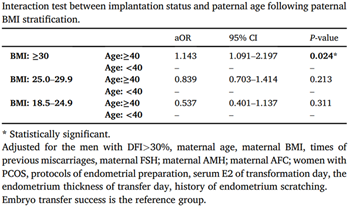Women with older and overweight partners are at higher risk of embryo implantation failure
Published 25 January, 2022
Over the past three decades, the age that couples in developed countries choose to have children has been rising steadily. This trend has become so pervasive that demographers have coined a term for it - postponement transition.
However, as fertility declines with age, older couples often find it harder to start a family. Some require medical support to conceive and successfully carry a baby full term. In a paper published in the KeAi journal Gynecology and Obstetrics Clinical Medicine, a group of researchers in China explored the effects of advanced paternal age (APA) and abnormal paternal weight (obesity) on in vitro fertilisation (IVF) treatment in nearly 800 couples who have experienced unexplained recurrent pregnancy loss (uRPL). Specifically, they considered the impact on embryo implantation, embryo quality and the health of the baby.
Corresponding author Junhao Yan, of Shandong University, explains: “While the effects of advanced maternal age (AMA) and maternal obesity on reproduction have been widely studied, investigations into the effects of APA and paternal weight are less common. This may be, in part, because the definition of APA is still up for debate - most studies set the age at between 40 and 50 years.”
The 779 couples the team recruited had undergone their first preimplantation genetic testing for aneuploidies (PGT-A) cycles – this information was invaluable in helping the researchers single out the impact of APA and paternal obesity.
Yan says: “In addition, we studied only women younger than 38 years of age so we could exclude factors such as age-related declines in egg and embryo quality. And our strict inclusion criteria ensured our study population was strongly heterogeneous.”
A generalised linear model (GLM) was used to adjust the data and test the interactions, assuring the accuracy and reliability of final conclusions. Yan says: “We found that after stratifying by paternal age, for every one-unit increase in BMI in older men, the risks of implantation failure in the women increased by 12.6% (aOR=1.126, 95%CI=1.016-4.097, P=0.039). As stratified by paternal BMI, if obese men were also older than 40, implantation failure risks in the women were 1.143 times greater than that of their counterparts (aOR= 1.143, 95%CI= 1.091-2.197, P= 0.024). When two or more male reproductive risk factors occurred at the same time, the negative paternal impacts on pregnancy outcomes were more likely to be significant. However, we found that paternal age and body mass index (BMI) had no significant impact on embryo quality and pregnancy outcomes.”
Yan concludes: “The definition of recurring pregnancy loss varies by country and society. Notably, there still are many causes that remain unknown. As such, it is not easy to predict which assisted reproductive technology is the best option to achieve pregnancy. The identification of these potentially modifiable risk factors may prove useful for some patients.”
###
Contact the corresponding author: Junhao Yan, yyy306@126.com
